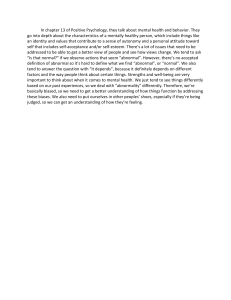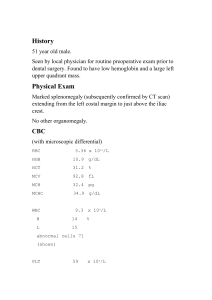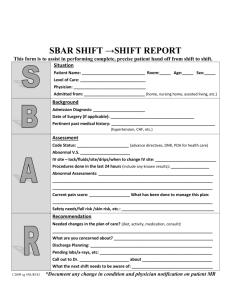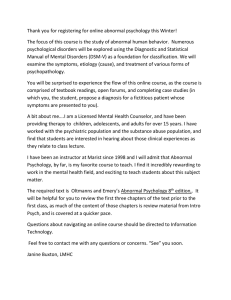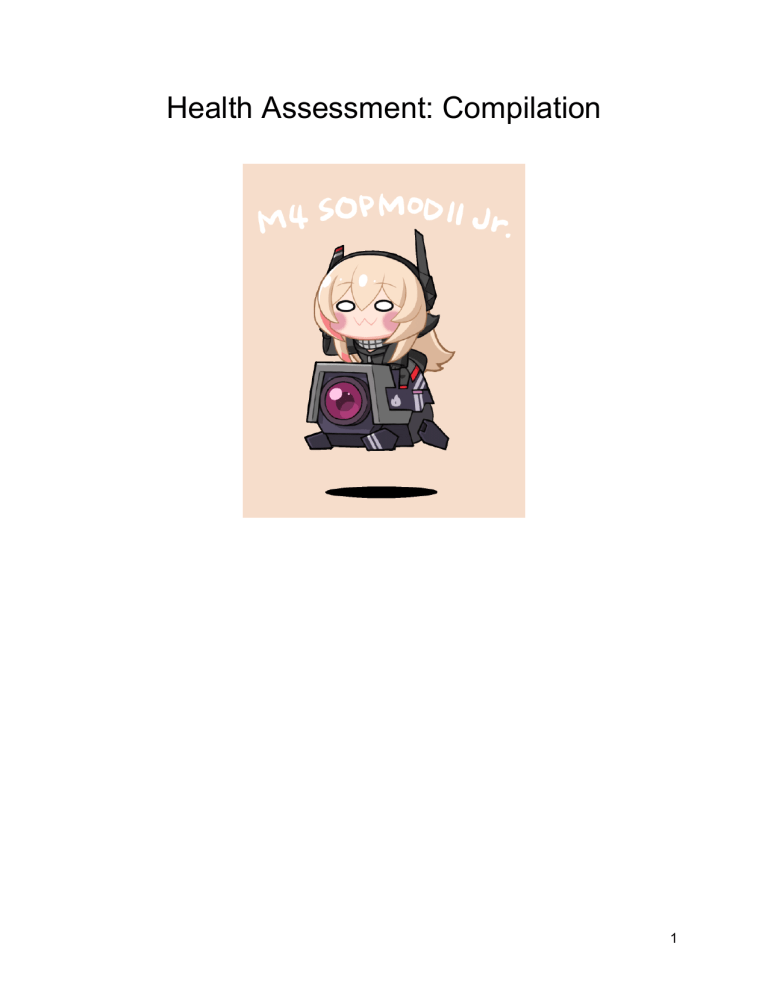
Health Assessment: Compilation 1 Assessment of the Eyes Preplanning Prepare Equipment - Penlight - Opaque Card / ¼ Illustration board - Snellen Chart - Book or Jaeger chart (Jaeger’s Test) - Cotton buds (for eversion) - Small ntbk for documentation (Depends on CI) Interview Procedures (Subjective Data) Before Questions - Introduce yourself - Explain Purpose - Ask for consent to continue (Is this the right time or are you doing something?) - Verify client’s identity (What is your name? When is your birthday?) - Ensure client is comfortable - Ask if the client wants to have someone by their side Questioning Current Symptoms - Recent changes in vision? = Possible acute problems such as head trauma or increased intracranial pressure 2 - Spots or floaters in front of eyes = Possible myopia, those above 40 have an increased chance of getting this - Blind spots, halos, or rings around lights? = Blind Spots (scotoma), Glaucoma, Vascular spasms (Ophthalmic Migraines) - Trouble seeing at night? = Night blindness (Optic Atrophy, Glaucoma, Vitamin A deficiency) - Double vision? = Often caused by Diplopia - Eye pain? = Often caused by burning or itching that originated from allergies or superficial irritation - Redness or swelling in eyes = Caused by an inflammatory response caused by allergies - Excessive watering or tearing or other discharge from eyes = Caused by Epiphora due to exposure to irritants Past History - Previous eye or vision problems (Medication, surgery, laser treatments, corrective lenses) Family History - Family history of eye problems or vision loss? Lifestyle and Health Practices - Exposure to chemicals, fumes, smoke, dust, flying sparks, etc? - Use of safety glasses - Use of sunglasses 3 - Medications (Corticosteroids, Lovastatin, Pyridostigmine, Quinidine, Risperdal, and rifampin) may have ocular side effects - Has vision loss affected ability to work or care for self or others - Date of last eye examination - Have glasses or contacts? Worn regularly? - Live or work around frequent or continuous loud noise? - Use of ear protection from noise or while in water. Physical Examination - Gather equipment - Explain procedures - (These 2 can be skipped if you have done them at the beginning) - Perform hand hygiene and wear gloves here Performance Vision Test - Distant Visual Acuity (Snellen’s Chart) = Normal result is 20/20 = Abnormal result means the person has Myopia (Impaired far vision) “So your results are 20/20 and I will explain to you what these results mean. 20 on the numerator means that you are 20 feet away from the snellen’s chart and 20 on the denominator means that you are able to interpret these letters at 20 feet while other people can also see them at 20 feet which means that both of your eyes are functioning well” - Near Visual Acuity (Jaeger) = Normal result is 14/14 = Abnormal result means that the person has Presbyopia (Impaired near vision) “Can you please read this paragraph and position it 14 inches away from your face? So your results are 14/14 which means that you are able to read the paragraph at 14 inches away and this is also the same with others” - Visual Fields (Confrontational) = Normal result means that the person was able to identify all numbers displayed in the 4 quadrants 4 = Abnormal result means that the person has a Reduced Peripheral Vision = 90 Temporally = 50 Superiorly = 70 Inferiorly = 60 nasally Extraocular Muscle Function - Corneal Light Reflex = Reflection of light on the corneas should be at the same spot = Abnormal, Asymmetric position of the light reflex means deviated alignment of the eyes due to muscle weakness or paralysis - Cover Test = Uncovered eye should remain straight ahead = Abnormal findings is that the covered eye loses focus and needs to reacquire it once uncovered = Phoria misalignment that occurs when the fusion reflex is blocked = Strabismus is constant malalignment of the eyes = Tropia specific misalignment (esotropia = inward turn of the eye, exotropia = outwards turn of the eye) - Position Test (9 positions, square shape) = Eye positions should be smooth and symmetric throughout all directions = Abnormal findings include Nystagmus which is the shaking movement of the eye which is associated from multiple sclerosis, brain lesions, or narcotics use External Eye Structures - Inspect eyelids, eyelashes = Normal, Upper lid should be at the upper margin, lower lid should touch the iris and eyelashes are distributed evenly = Abnormal, Drooping upper lid (Blepharoptosis) - Inspect eyeball position = Normal, Eyeballs are not protruding or sinking 5 = Abnormal, Protruding eyeballs as a result from exophthalmos (Retracting eyelid margins), and hyperthyroidism - Inspect bulbar conjunctiva and sclera Normal: clear moist, smooth and transparent, visible blood vessels Abnormal: General redness conjunctivitis (Pink eye), Dry areas due to allergies - Inspect Palpebral Conjunctiva Normal: Lower and upper palpebral conjunctivae are clear and free of swelling or lesions Abnormal: cyanosis (may suggest a heart or lung disorder) or a foreign object is present - Inspect lacrimal apparatus Normal: no swelling or redness Abnormal: Swelling may be caused by an infection, blockage, inflammatory condition - Palpate lacrimal apparatus Normal: No drainage from the puncta when palpating Abnormal: Present drainage means that there is a duct blockage - Inspect cornea and lens Normal: Transparent with no opacities, oblique view shows a smooth surface Abnormal: is rough or dry which is associated with an injury or allergic responses, if opacities are seen then there is a possible cataract - Inspect iris and pupil Normal: Iris is round, flat color brown, pupils are 3-5 mm in size, circular shape Abnormal: Irregular shaped irises, miosis, mydriasis, and anisocoria 6 - Test pupillary reaction to light Normal: Bilateral constriction of pupils to light is observed Abnormal: Other eye does not constrict, Monocular blindness is present - Test accommodation of pupils Normal: Eyes converge when focusing on the object and pupils constrict Abnormal: Pupils do not constrict and converge Finalizing - Conclude interview and physical assessment - Say full name and status (Name_ I am a student nurse from MTC) - Thank patient for cooperation 7 Assessment of the Ears Preplanning Prepare Equipment - Penlight - Tuning Fork - Alcohol - Gloves - Second Hand watch (For timing the Rinne test) Interview Procedures (Subjective Data) Before Questions - Introduce yourself - Explain Purpose - Ask for consent to continue (Is this the right time or are you doing something?) - Verify client’s identity (What is your name? When is your birthday?) - Ensure client is comfortable - Ask if the client wants to have someone by their side Questioning 8 Current Symptoms - Recent changes in hearing (If yes, were all or just sounds affected) Normal: no changes Abnormal: Decrease in one ear may mean otitis media, earwax (cerumen) impaction, Foreign body obstruction. Presbycusis is observed when the hearing loss of high pitched the low pitched sounds is confirmed - Ear Discharge (If yes, amount/odor) Normal: No discharge Abnormal: Otorrhea is seen which means an infection is present, Bloody drainage means infection on the external ear (External otitis) - Ear Pain (If yes, is there accompanying sore throat, sinus infection, or problem with teeth or gums)? Normal: No pain Abnormal: Pain may be caused by Otorrhea, cerumen blockage, Sinus infections, teeth and gum problems - Ringing or crackling in ears? Normal: No pain Abnormal: Tinnitus is present, caused by excessive earwax buildup and high blood pressure 9 Past History - Previous ear or hearing problems such as infections, trauma, or earaches (Medications, surgery, hearing aids)? (Client may be dissatisfied of with past treatments for hearing problems) Family History - Family history of ear problems or hearing loss? (Hearing loss may be age related, May be related to Otosclerosis which is the fusion of the ossicles at the middle ear over time to construct the transmission of sound) Lifestyle and Health Practices - Live or work around frequent or continuous loud noise? (Loud noises can give you hearing loss) - Use of ear protection from noise while in water? (Otitis externa or swimmer’s ear is the growth of germs at the ear canal due to being submerged in water for a long period of time) - Has hearing loss affected the ability to work or care for self or others? (Activities of Daily life may be affected in which they are unable to interact with the world properly) 10 Physical Assessment External Ear Structures - Inspect the auricle, tragus, and lobule for size and shape, position, lesions/discoloration, and discharge. Normal: Ears equal in size bilaterally (4-10 cm), auricle aligns with the corner of each eye, Smooth skin, no lesions, consistent color, no discharge Abnormal: Ears are smaller than 4 cm or larger than 10 cm, Malalignment may be caused by genitourinary disorders or chromosomal defects Macrotia - excessive ear enlargement, Related to other congenital anomalies - Palpate the auricle and mastoid process for tenderness. Normal: No tenderness was felt by the patient Abnormal: Tenderness is present Hearing and Equilibrium Tests - Perform the whisper test by having the client place a finger on the tragus of one ear. Whisper a two-syllable word 30.4-60.9 cm (1-2 ft) behind the client. Repeat on the other ear. Whisper 6 words per ear have them repeat what you have said after whispering Normal: Was able to repeat all 2-syllable words as whispered on both ears Abnormal: Has more than 2 tries trying to repeat the 2-syllable words 11 - Perform the Weber test by using a tuning fork placed on the center of the head or forehead and asking whether the client hears the sound better in one ear or the same in both ears. Normal: Vibrations are heard equally in both ears, No lateralization of sound to either ear Abnormal: Vibration is felt more on the poor ear indicating conductive loss, If vibration is felt more on the good ear then sensorineural loss is observed - Perform the Rinne test by using a tuning fork and placing the base on the client's mastoid process. When the client no longer hears the sound, note the time interval, and move it in front of the external ear. When the client no longer hears a sound, note the time interval. Normal: Air conduction if longer than Bone conduction Abnormal: Bone Conduction is greater or equal than Air Conduction resulting in Conductive hearing loss If Air Conduction is 3 times longer than Bone Conduction and Sensorineural Hearing Loss is observed Finalizing - Conclude interview and physical assessment - Say full name and status (Name_ I am a student nurse from MTC) - Thank patient for cooperation 12 Assessment of the Mouth Preplanning Prepare Equipment - Tongue Depressor - Cotton Gauze Pads - Alcohol - Gloves - Penlight Interview Procedures (Subjective Data) Before Questions - Introduce yourself - Explain Purpose - Ask for consent to continue (Is this the right time or are you doing something?) - Verify client’s identity (What is your name? When is your birthday?) - Ensure client is comfortable - Ask if the client wants to have someone by their side 13 Questioning Current Symptoms 1. Mouth problems (tongue or mouth sores or lesions, gum or mouth redness, swelling, bleeding, or pain)? Normal: No Mouth Problems Abnormal: Red swollen gums are seen which can easily occur gum disease (Gingivitis) or the recession on gums (Periodontitis) is observed 2. Sinus problems (pain over sinuses, postnasal drip)? Normal: No Sinus problems Abnormal: Pain, tenderness, swelling, clear drainage (Rhinorrhea) indicates chronic allergy 3. Nose problems (nosebleeds, stuffy nose, cannot breathe through one or both nostrils, change in ability to smell or taste)? Normal: No Nose problems Abnormal: Bleeding at the nose (Epistaxis) may be due to trauma, mucosal irritation,inflammatory diseases,etc. Pain, tenderness, swelling are felt, Decrease in taste and smell means there are lesions at certain nerves. Past History 1. Previous problems with mouth, throat, nose, or sinuses (surgeries or treatment; how much and how often)? (Might be the result of a surgery or treatment) 2. Use of nasal sprays? (Determines if the spray is effective) 3. History of tooth grinding? 14 4. Last dental exam? Fit of dentures? Family History 1. Family history of oral, nasal, or sinus cancer or chronic problems? (May be caused by genetics) Lifestyle and Health Practices 1. Daily practice of oral care, tooth care, or denture care? 2. Usual diet? 3. History of smoking, use of, how much, and how often? (Increases chance for oral or lip cancer_ 4. Use of alcohol (how much and how often)? (Excessive alcohol such as 21 bottles a week increases oral cancer) Physical Examination 1. Gather equipment (gloves, cotton gauze pads, penlight, speculum attached to otoscope, tongue blade). 2. Explain the procedure to the client. Mouth 1. Note any distinctive odors. (Do not let the patient know you are checking for this as it may seem offensive) Normal: No distinctive odors Abnormal: Has Halitosis, may indicate bacteria infection 15 2. Inspect and palpate lips, buccal mucosa, gums, and tongue for color variations (pallor, redness, white patches, bluish hue), moisture, tissue consistency, or lesions (induration, roughness, vesicles, crusts, plaques, nodules, ulcers, cracking, patches, bleeding, Koplik spots, cancer sores), Stensen and Wharton ducts. Normal: Smooth, Moist, no lesions and free from swelling Abnormal: Dry, cracked lips indicate dehydration, Lesions indicate lip cancer 3. Inspect gums for hyperplasia, blue-black line. Normal: Tissues along the gums are smooth and moist Abnormal: Red swollen gums that blend easily are seen in gingivitis, and scurvy (Vitamin C deficiency) 4. Inspect teeth for number and shape, color (white, brown, yellow, chalky white areas), occlusion. Normal: 32 pearly white teeth, Smooth edges and surfaces, No missing teeth, Jaws are aligned with no deviation seen when biting down Abnormal: Yellowish or Brown teeth from excessive smoking or consumed too much coffee. If the teeth of the upper and lower protrude then Malocclusion is observed 16 5. Inspect and palpate tongue for color, texture, and consistency (black, hairy, white patches, smooth, reddish, shiny without papillae), moisture, and size (enlarged or very small). Normal: Tongue should be pink, moist, and a moder- ate size, with papillae (little protuberances) present. No lesions or ulcerations present. Abnormal: The tongue is yellow, or white which either indicates digestive system disorders or infection. Dry nodules, ulcers present papillae or fissures absent; asymmetrical. Deep longitudinal fissures are seen in dehydration; black hairy tongue indicates Oral Leukoplakia. Throat 1. Inspect the throat for color, consistency, torus palatinus, uvula (singular). Normal: No lesions, color pink, no signs of tonsillitis Abnormal: 2. Inspect the tonsils for color and consistency, grading scale (1+, 2+, 3+, 4+). Normal: Tonsils may be present or absent. They are normally pink and symmetric and may be enlarged to 1+ in healthy clients. No exudate, swelling, or lesions should be present. Abnormal: Tonsils are red, enlarged (to 2+,3+, or 4+), and covered with exudate in tonsillitis. They also may be indurated with patches of white or yellow exudate 17 Nose 1. Inspect and palpate the external nose for color, shape, consistency, tenderness, and patency of airflow, Normal: Color is the same as the rest of the face; the nasal structure is smooth and symmetric; the client reports no tenderness. Abnormal: Nasal tenderness on palpation accompanies a local infection. 2. Inspect the internal nose for color, swelling, exudate, bleeding, ulcers, perforated septum, or polyps Normal: The nasal mucosa is dark pink, moist, and free of exudate. The nasal septum is intact and free of ulcers or perforations. Turbinates are dark pink (redder than oral mucosa), moist, and free of lesions. Abnormal: Nasal mucosa is swollen and pale pink or bluish gray in clients with allergies. Nasal mucosa is red and swollen with upper respiratory infec- tion (URI). Exudate is common with infection and may range from large amounts of watery discharge to thick yellow-green, purulent discharge. Purulent nasal discharge Sinuses 1. Palpate the sinuses for tenderness. Normal: Frontal and maxillary sinuses are nontender to palpation, and no crepitus is evident. Abnormal: Frontal or maxillary sinuses are tender to palpa- tion in clients with allergies or acute bacterial rhinosinusitis. If the client has a large amount of exudate, you may feel crepitus upon palpation over the maxillary sinuses. This may also be present with a viral URI. 18 2. Percuss and transilluminate the sinuses for air versus fluid or pus Normal: The sinuses are not tender on percussion. Abnormal: The frontal and maxillary sinuses are tender upon percussion in clients with allergies or sinus infection. 19
